Printable primary worksheets
All of our resources come complete with answer sheets to save time for busy teachers and parents. Input your child’s scores and keep track of your child's progress.
worksheet plans from £3.20/monthAll of our resources come complete with answer sheets to save time for busy teachers and parents. Input your child’s scores and keep track of your child's progress.
worksheet plans from £3.20/month New
New
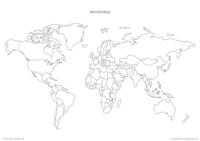
Blank World Map This blank world map is a versatile and valuable resource for educators teaching KS2 geography. Whether used as a standalone activity or integrated into lesson plans, this map encourages kids to explore and engage with key geographical concepts. Educators can use the map as a tool for teaching kids about the location of different countries around the world. Students can label countries, capital cities, and key landmarks.Whether used for basic geographical identification or more complex analysis of global issues, this map provides students with a foundation for understanding the world around them and encourages active exploration and learning.
 New
New
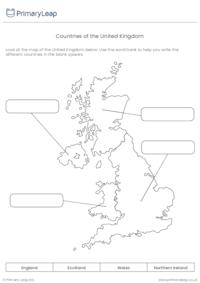
Countries of the United Kingdom ActivityThis engaging worksheet is designed to reinforce students' locational knowledge of the countries comprising the United Kingdom: England, Scotland, Wales, and Northern Ireland. By accurately labelling these countries on a map, students will deepen their understanding of UK geography and develop spatial awareness skills.The primary objective of this worksheet is to familiarise students with the geographical locations of the countries within the United Kingdom. Through this activity, students will enhance their ability to identify and differentiate between these countries on a map. Encourage students to compare and contrast the countries of the United Kingdom in terms of size, population, and geographical features.
 New
New
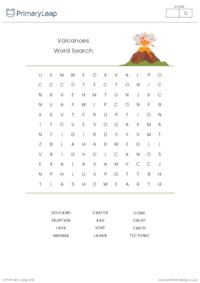
Embark on an exciting journey into the world of volcanoes with this engaging KS2 geography word search! Designed to captivate young minds and reinforce key vocabulary related to volcanic activity, this word search is an ideal educational tool for parents and teachers alike. Usage:Perfect for classroom activities, homework assignments, or educational enrichment at home.Suitable for individual or group work, fostering collaboration and peer learning.
 New
New
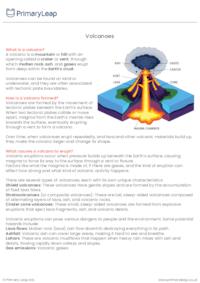
UKS2 Volcanoes ActivityThis engaging worksheet introduces students (UKS2) to the fascinating world of volcanoes. Through clear and concise explanations, students will learn about the formation of volcanoes, why they erupt, different types of volcanoes, associated dangers, and safety precautions during eruptions. Accompanied by a colourful diagram, this worksheet offers a comprehensive overview of volcanoes, making it an excellent resource for educators, parents, and teachers seeking to enhance their students' understanding of Earth's dynamic geological features. This resource can either be used in the classroom or at home.
 New
New
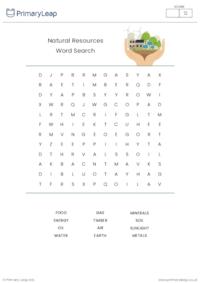
Natural Resources Word SearchWord searches are not just fun puzzles; they're valuable educational tools that can enhance learning experiences for KS2 students in geography and beyond. Whether used in classrooms or at home, word searches offer numerous benefits for young learners. They provide an engaging way for students to familiarise themselves with vocabulary related to natural resources. By searching for and identifying words like "water," "minerals," and "energy," students reinforce their understanding of key terms essential for geography lessons.Word searches offer a fun and engaging way to learn, making them suitable for both classroom use and independent study at home. Students are motivated to complete the puzzle as they enjoy the challenge of finding and circling the hidden words. By incorporating word searches focused on natural resources into your KS2 geography curriculum, you can create an enriching learning experience that sparks curiosity and deepens students' understanding of the world around them. Whether used as standalone activities or integrated into broader lesson plans, word searches offer a dynamic and effective way to engage students in exploring the fascinating topic of natural resources.
 New
New
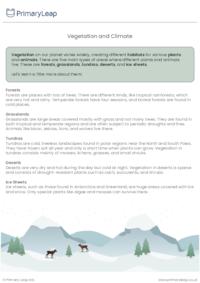
This engaging worksheet is designed to introduce KS2 students to the fascinating world of Earth's biomes – the diverse habitats that shape our planet's landscapes and support a wide variety of plant and animal life.Students will explore five main types of biomes: forests, grasslands, tundras, deserts, and ice sheets. They'll learn about the unique characteristics of each biome, from the towering trees of forests to the frozen expanses of ice sheets.Aligned with the UK national curriculum, this worksheet encourages students to match biome characteristics, identify vegetation types, and understand the environmental factors that influence each biome. It's a fantastic resource for sparking curiosity and deepening geographical knowledge.
 New
New
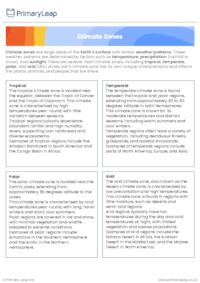
KS2 Climate Zones WorksheetThis KS2 geography worksheet, "Climate Zones," is designed to help educators teach students about the different climate zones found on Earth. Through engaging descriptions and thought-provoking questions, students will explore the characteristics of tropical, temperate, polar, and arid climate zones.The worksheet begins with brief descriptions of each climate zone, providing key information about their locations, temperature patterns, vegetation, and examples of regions within each zone. Students will learn about the unique features of tropical regions near the equator, temperate regions with distinct seasons, polar regions with extreme cold temperatures, and arid regions with low precipitation levels.Educators can use this worksheet as part of their geography curriculum to introduce or reinforce the concept of climate zones. It can be used in classroom settings, as homework assignments, or as supplementary material for independent study. By completing this worksheet, students will gain a deeper understanding of the diverse climates that exist across the globe and the factors that influence them.
 New
New
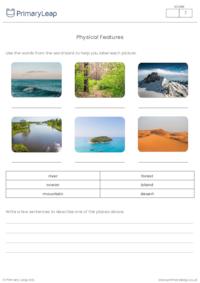
Our Labelling Physical Features activity is designed to engage KS1 students in learning about key geographical features such as mountains, oceans, deserts, rivers, forests, and islands. This worksheet aims to develop students' understanding of these features and their significance in shaping our planet's landscapes.How will this worksheet help my students?The objective of this worksheet is to help students identify and label different physical features correctly, enhancing their knowledge of basic geography concepts.
 New
New
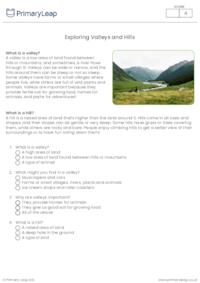
KS1 Valleys and Hills WorksheetIn this worksheet, students will explore the characteristics and significance of valleys and hills through simple and relatable descriptions. They will learn about the defining attributes of valleys, including their low-lying nature, association with hills or mountains, and the presence of rivers. Additionally, students will discover the various features of hills, such as their raised elevation, diverse shapes, and the enjoyment people derive from them.Educational Objectives:Identify the key characteristics of valleys and hills.Understand the importance of valleys and hills in the environment.Develop comprehension skills through reading and answering questions.Foster an appreciation for the natural world and its diverse landscapes.How to Use:Download and distribute the worksheet to students.Encourage students to read the passages about valleys and hills carefully.Have students answer the comprehension questions provided, either independently or in small groups.Review the answers together as a class, discussing any misconceptions and reinforcing key concepts.Download the worksheet today and embark on an exciting journey of discovery with your KS1 students!
 New
New
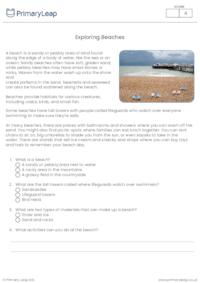
KS1 Exploring Beaches Worksheet"Exploring Beaches" offers a comprehensive and engaging resource for KS1 geography lessons, providing students with a deeper understanding of coastal environments. Following the exploration of beaches, students will engage in comprehension questions that reinforce their understanding of the material covered. These questions are designed to assess students' knowledge of beach features and their ability to recall information from the passage.Educational Goals:Understand what beaches are and where they're found.Recognise and describe natural and human-made features of beaches.Practise reading and comprehension skills in a fun and relaxed setting.Develop a love for exploring nature and the great outdoors.
 New
New
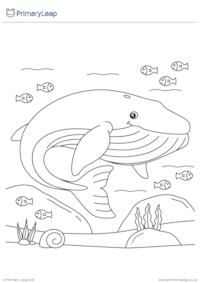
Created for KS1 geography lessons, this worksheet encourages young adventurers to explore the depths of the ocean while expressing their creativity through colouring. Students will embark on an exciting journey to discover the largest creature in the ocean, the magnificent blue whale.Fun Facts about Blue Whales:Blue whales are the largest animals on Earth, growing up to 100 feet long and weighing as much as 200 tons.They have a deep blue-grey colouration and a distinctive mottled appearance.Blue whales consume up to 4 tons of krill, their primary food source, in a single day.Their powerful vocalizations, known as whale songs, can be heard across vast distances in the ocean.Blue whales undertake long migrations between feeding and breeding grounds.
 New
New

Embark on a thrilling Arctic adventure with our Walrus Colouring Activity! Tailored for KS1 geography lessons, this worksheet invites young explorers to journey to the icy waters of the Arctic while expressing their creativity through colouring. Introduce students to intriguing tidbits about walruses, such as their impressive tusks, blubbery bodies, and unique adaptations for Arctic survival. Learning about these remarkable creatures adds excitement and curiosity to the colouring experience.Fun Facts about Walruses:Walruses are large marine mammals that inhabit the Arctic Ocean and surrounding seas.They are known for their distinctive tusks, which are elongated canine teeth used for various purposes, including foraging and defence.Walruses have a thick layer of blubber that helps them stay warm in cold Arctic waters.They use their sensitive whiskers to detect food on the ocean floor, such as clams and other shellfish.Walruses are highly social animals and often gather in large groups, known as herds, on land and ice floes.
 New
New
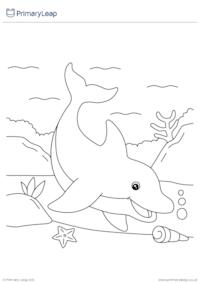
Colouring has been shown to have calming effects on students, promoting relaxation and reducing stress levels. This activity provides a tranquil and enjoyable learning experience, allowing students to unwind as they connect with the ocean and its inhabitants. Tailored for KS1 geography lessons on the five oceans, this worksheet invites young learners to embark on an exciting journey through the depths of the sea while expressing their creativity through colouring.Fun Facts about Dolphins:Dolphins are highly intelligent mammals, known for their complex social behaviours and communication skills.They use echolocation, a type of sonar, to navigate and locate prey underwater.Dolphins are incredibly playful animals and often engage in acrobatic displays, riding waves and leaping out of the water.Some dolphin species, such as the bottlenose dolphin, can swim at speeds of up to 20 miles per hour.Dolphins are known for their strong bonds with each other and often form close-knit groups called pods.
 New
New
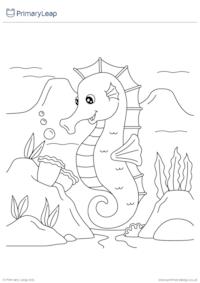
Colouring has calming effects on students, promoting relaxation and reducing stress levels. This activity provides a peaceful and enjoyable learning experience, allowing students to unwind as they dive into the world of seahorses. Perfect for KS1 geography lessons on the five oceans, this worksheet invites young explorers to dive into the whimsical realm of seahorses while unleashing their creativity through colouring.
 New
New
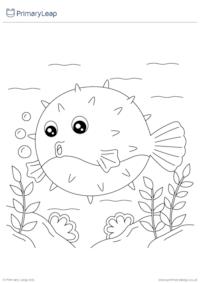
Embark on an undersea journey filled with wonder and excitement with our delightful Pufferfish Colouring Activity! This engaging worksheet is designed to accompany KS1 geography lessons on the five oceans, offering young learners an opportunity to discover the unique charm of the pufferfish while unleashing their creativity through the art of colouring. Introduce students to some fascinating facts about pufferfish, such as their ability to inflate themselves when threatened and their unique defence mechanisms. Learning about these quirky characteristics adds an element of fun and curiosity to the colouring activity.
 New
New
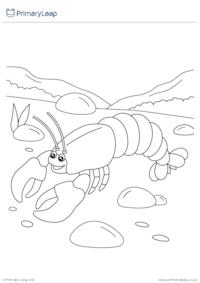
Spark your students' sense of wonder and curiosity with our Lobster Colouring Activity, a delightful addition to your KS1 geography lessons on the five oceans. Through the exploration of marine life, students embark on a journey of discovery and creativity, deepening their connection to the natural world and fostering a lifelong appreciation for the beauty and diversity of ocean ecosystems.
 Free
Free
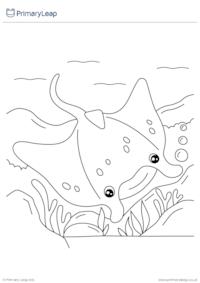
Ignite your students' curiosity and imagination with this Stingray Colouring Activity, a perfect addition to your KS1 geography lessons on the five oceans. Through the exploration of marine creatures, students embark on a journey of discovery and creativity, fostering a deeper connection to the natural world and the wonders that lie beneath the waves.
 New
New
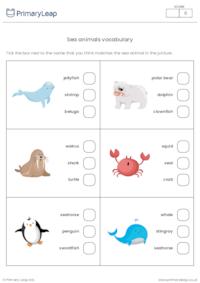
Incorporating this sea animal identification worksheet into KS1 geography lessons not only adds an element of excitement and engagement but also empowers students to actively explore and appreciate the wonders of the natural world. Tailored specifically for KS1 students, this worksheet provides a dynamic platform for young learners to delve into the captivating world of marine life while honing essential academic skills.
 New
New
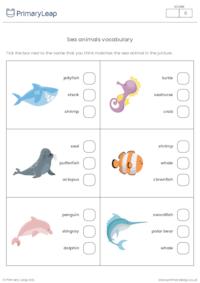
Sea Animals Vocabulary WorksheetThis sea animal identification worksheet is a fantastic addition to KS1 geography lessons, offering a fun way for students to learn about the five oceans and the creatures that inhabit them. By engaging with colourful illustrations and multiple-choice options, children can deepen their understanding of marine ecosystems while honing their academic skills in an enjoyable way.
 New
New
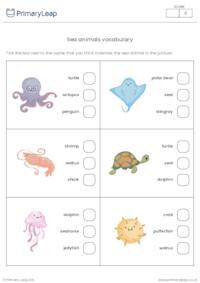
Sea Animals Vocabulary This handy worksheet is designed to engage KS1 pupils in an interactive learning activity focused on identifying sea animals. With colourful illustrations and multiple-choice options, this worksheet provides an opportunity for children to strengthen their knowledge of marine life while practising their decision-making skills.
 New
New
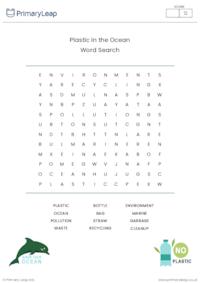
Plastic in the Ocean Word Search ActivityOur "Plastic in the Ocean Word Search" worksheet is an engaging and educational activity designed for KS1 pupils to learn about the issue of plastic pollution in the ocean. This word search provides a fun way for students to familiarise themselves with vocabulary related to this important environmental topic.Benefits:Helps students learn and recognise words related to plastics in the ocean, such as "plastic," "pollution," "recycling," and more.Raises awareness about the impact of plastic pollution on marine life and the environment.Enhances students' vocabulary by introducing new words and concepts related to environmental conservation.Encourages students to think critically about environmental issues and the importance of reducing plastic waste.
 New
New
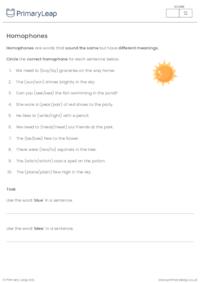
Homophones activityThis worksheet focuses on homophones, which are words that sound the same but have different meanings and often different spellings. In this worksheet, pupils will practise identifying the correct homophone for each sentence by circling the appropriate word. This activity encourages them to pay attention to context clues and understand the subtle differences in meaning between homophones.Through this exercise, children develop their vocabulary, spelling, and comprehension skills. By distinguishing between homophones, they sharpen their ability to choose the right word based on the context of a sentence, enhancing their overall writing and communication abilities. After completing the sentences, there are two additional tasks where your child will use the words 'blue' and 'blew' in sentences of their own. This reinforces their understanding of the meanings of these homophones and encourages creativity in sentence construction. This worksheet provides an engaging and practical way for kids to practise homophones, helping them become more confident and proficient readers and writers.
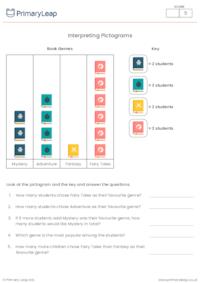
This handy maths worksheet is designed to introduce students to the concept of pictograms while exploring their favourite book genres. The worksheet is a visually engaging and enjoyable way to enhance students' skills in data representation and interpretation, aligning with the national curriculum. The worksheet includes a colourful pictogram featuring icons representing four popular book genres: Mystery, Adventure, Fantasy, and Fairy Tales. Each icon corresponds to a certain number of students who prefer that genre.Learning Objectives:Develop the ability to read and interpret data presented in a pictogram.Practise counting and comparing quantities through visual representations.Enhance problem-solving skills by answering questions that require data analysis.Reinforce maths skills within a context that relates to students' interests, encouraging them to explore their favourite book genres.
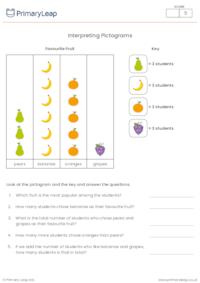
Interpreting PictogramsThis maths worksheet is a fun and engaging activity designed to help students practise data representation and interpretation through the use of a pictogram. The worksheet focuses on students' favourite fruits, a topic that is relatable and interesting for young learners. The worksheet provides a colourful pictogram with images of four different fruits: pears, bananas, oranges, and grapes. Each fruit icon represents a certain number of students who chose it as their favourite.Learning Objectives:Develop the ability to read and interpret data presented in a pictogram.Practise counting and comparing quantities based on images.Enhance problem-solving skills by answering questions that require data analysis.Reinforce maths skills through a real-world context that is relevant to students' interests.
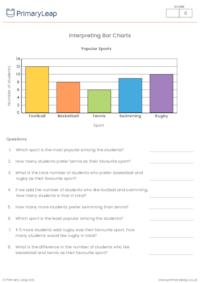
Interpreting Bar ChartsThis worksheet encourages students to explore data representation, make comparisons, and practise basic arithmetic operations while having fun with popular sports. It's designed to promote a strong foundation in statistics and problem-solving skills, in accordance with the Year 4 curriculum.
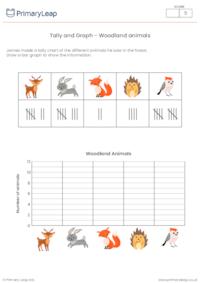
Tally and Graph - Woodland animalsThis worksheet is designed to help students grasp the fundamentals of creating a bar chart. It begins by providing a set of tally data related to woodland animals. Students are tasked with taking this tally data and using it to construct their own bar chart.
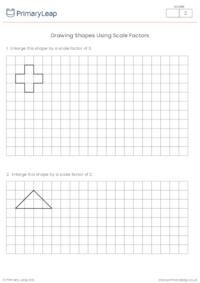
How will this worksheet help my child?With this handy maths worksheet, students will practise drawing shapes according to given scale factors. It aligns with the national curriculum and focuses on developing students' skills in creating and visualising geometric figures with the use of scale factors. This activity will enhance their understanding of how scale factors can be applied to resize and recreate shapes accurately.
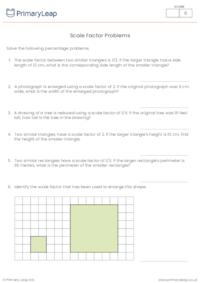
Shapes and Scale FactorsThis handy maths worksheet is designed to help students grasp the concept of scale factors and their applications. It aligns with the national curriculum and is tailored to enhance students' understanding of how objects and shapes can change in size while maintaining proportionality.
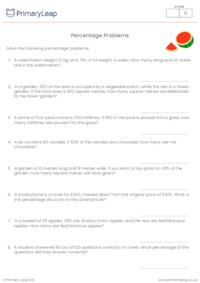
Percentage problems activityThis Year 6 math worksheet is designed to help students practice solving percentage problems. It aligns with the national curriculum and focuses on the calculation of percentages and the use of percentages for comparison. The worksheet includes a variety of real-world scenarios and challenges that will test students' understanding of percentages.
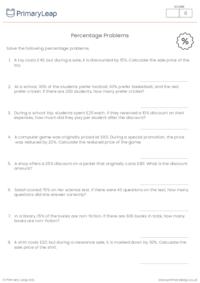
How will this worksheet help students?This year 6 maths worksheet on percentage problems will help students practise solving real-life problems involving percentages. The worksheet aligns with the National Curriculum and is aimed at enhancing students' understanding of percentages and their practical applications. Students will solve a variety of problems, including finding discounts, calculating percentages of quantities, and determining preferences based on percentages. This worksheet offers eight questions with answers provided, encouraging students to apply their knowledge of percentages to practical scenarios.
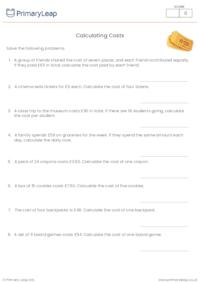
How will this worksheet help my child?This maths worksheet focuses on developing students' skills in calculating costs using integer multiplication and division. The worksheet provides practical scenarios involving purchases and expenses, challenging students to find the cost of individual items or the daily expenses. By practising these problems, students will reinforce their understanding of how to use basic maths operations to calculate costs in real-life situations. This worksheet aligns with the National Curriculum and aims to improve students' ability to solve problems involving the relative sizes of two quantities.
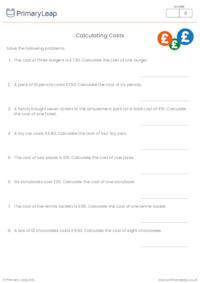
Calculating costs activityWith this maths worksheet, students will solve problems related to calculating costs. They will use their knowledge of integer multiplication and division facts to find missing values.
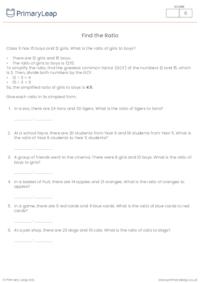
Find the RatioThis maths worksheet is tailored to reinforce students' understanding of ratios and proportions. The worksheet includes problems where students will determine the ratios between different quantities. They will work with real-life scenarios to calculate and express these ratios. The worksheet is designed to help students practise finding and expressing ratios as well as simplifying them when necessary. This worksheet is an ideal resource for Year 6 students looking to enhance their skills in working with ratios and proportions.
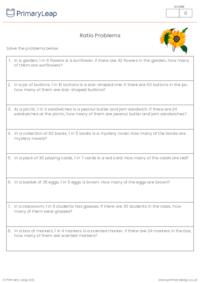
Ratio problems worksheetThis maths resource focuses on ratios, specifically designed to help students develop a strong understanding of these concepts. The worksheet includes problems where students will practise finding and simplifying ratios. They will work with real-life scenarios such as zoo animals, classroom students, and more, calculating the ratios and simplifying them to express the relationships between different quantities. This worksheet aims to reinforce essential skills in solving problems involving ratios, making it suitable for students looking to enhance their proficiency in this topic.
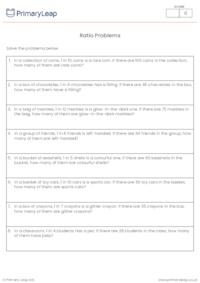
Ratio problems worksheetThis maths activity focuses on ratios and proportions, specifically designed to help students develop a strong understanding of these concepts. The worksheet includes problems where students will practise finding and simplifying ratios. They will work with real-life scenarios such as zoo animals, classroom students, and more, calculating the ratios and simplifying them to express the relationships between different quantities. This worksheet aims to reinforce essential skills in solving problems involving ratios, making it suitable for students looking to enhance their proficiency in this topic.
 Free
Free
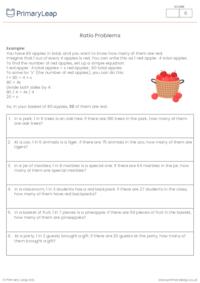
Ratio problems worksheetThis Year 6 math worksheet focuses on ratios and proportions, specifically designed to help students develop a strong understanding of these concepts. The worksheet includes problems where students will practise finding and simplifying ratios. They will work with real-life scenarios such as zoo animals, classroom students, and more, calculating the ratios and simplifying them to express the relationships between different quantities. This worksheet aims to reinforce essential skills in solving problems involving ratios, making it suitable for students looking to enhance their proficiency in this topic.
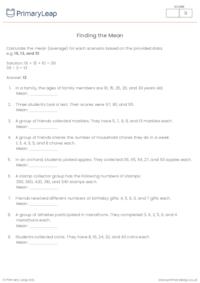
Finding the Mean with ScenariosThis worksheet iprovides Year 6 students with opportunities to practise calculating the mean (average) within the context of various real-world scenarios. Students will use whole numbers to calculate the mean based on different sets of data related to scenarios involving friends, activities, and collections.
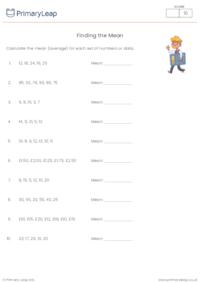
Finding the MeanThis handy worksheet will help students practise and master the skill of finding the mean (average) of a set of numbers or data. Students will work with various sets of data, both numerical and categorical, to calculate the mean and express it as a numerical value. By working with various sets of data and practising the calculation of the mean, students will enhance their numeracy skills and develop a solid grasp of the concept of average.
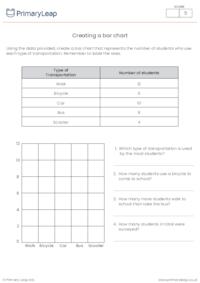
Creating a Bar ChartThis worksheet aims to engage students in the process of creating a bar chart based on real-world data. Students will use the provided data and scenario to construct a bar chart and then answer questions related to the chart. This activity fosters data representation and analysis skills.
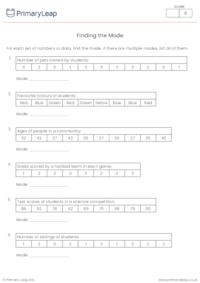
This worksheet is intended for use in the classroom, as a homework assignment, or as part of a larger unit on statistics and data analysis. Mode is the value that appears most frequently in a dataset. Students will work with a range of numerical sets and data scenarios to calculate the mode, including the possibility of having multiple modes.
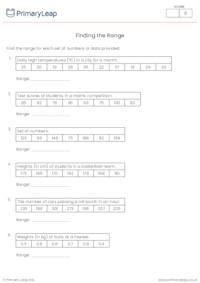
Use this worksheet to help students deepen their understanding of the concept of "range." Range is the difference between the largest and smallest numbers in a set of data. Students will work with larger numbers and more complex data sets to calculate the range in various scenarios.
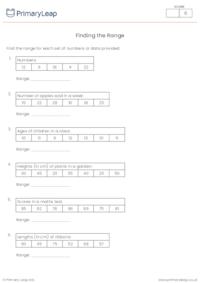
Practising RangeUse this worksheet to help students practise the concept of "range," which is the difference between the largest and smallest numbers in a set of data. In this worksheet, students will work with both numbers and data sets.
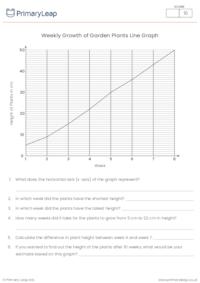
Weekly Growth of Garden Plants Line Graph ActivityUse this worksheet to help students practise interpreting data from a line graph. Students will analyze a line graph representing the weekly growth of plants in a garden and answer questions related to the graph. This worksheet can be used in the classroom, as a homework assignment, or as part of a larger unit on data analysis and interpretation. It aims to improve students' skills in reading and understanding line graphs while engaging them with real-world data related to plant growth. There are 10 questions for students to answer.
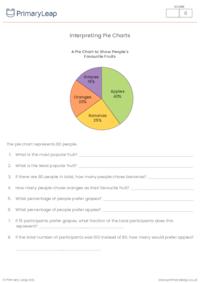
Interpreting Pie ChartsThis worksheet is designed to engage students in exploring data visualization through a pie chart. Students will work with data representing the favorite fruits of a group of participants. They will interpret the data in the form of a pie chart and answer questions related to the chart.Pupils will:Understand how to interpret and analyse data presented in a pie chart.Identify the most and least preferred fruits among participants.Practise calculating percentages based on the pie chart data.Work with fractions in the context of data analysis.
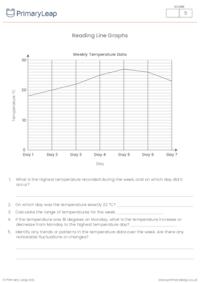
Reading Line GraphsUse this handy worksheet to help students practise interpreting and analysing data presented in a line graph. The line graph displays temperature data over the course of a week. Students will engage with the graph to answer questions that require them to identify temperature trends, extremes, and averages within the dataset. This worksheet can be used effectively in the classroom for interactive learning. Educators can provide guidance and facilitate discussions as students work on the questions. It is also suitable for homework assignments, allowing students to practise their data analysis skills independently. This activity can be a valuable addition to the curriculum for reinforcing data analysis and visualisation skills, both in the classroom and as homework.
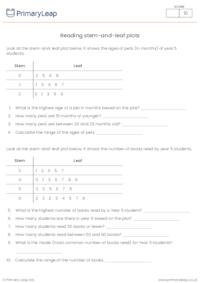
Reading stem-and-leaf plotsThis worksheet is designed for students to practise interpreting stem-and-leaf plots. Stem-and-leaf plots are a visual representation of data that help us understand the distribution of values within a dataset. In this activity, students will work with data related to the number of books read by year 5 students. They will answer questions to analyse the information presented. This activity can be a valuable addition to the curriculum to reinforce data analysis and visualisation skills.
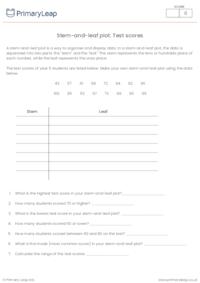
What is a stem-and-leaf plot? A stem-and-leaf plot is a way to organise and display data. In a stem-and-leaf plot, the data is separated into two parts: the "stem" and the "leaf." The stem represents the tens or hundreds place of each number, while the leaf represents the ones place.Students create their own stem-and-leaf plot using the data on the worksheet. After creating their plot, they answer seven questions based on their plot. This activity will help students understand what a stem-and-leaf plot is and practise creating their own plots based on given data. The questions aim to reinforce their knowledge and interpretation of stem-and-leaf plots. Review the answers with the students to ensure their comprehension of the concept.
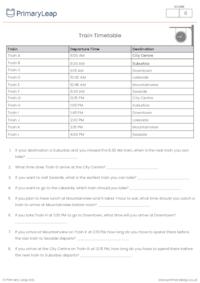
Train Timetable for a Day ActivityThis worksheet is designed to challenge students in reading and interpreting train timetables while promoting critical thinking and time management skills. Students will be required to analyse the provided train schedule and answer questions that involve planning journeys, calculating travel times, and making connections.




Check out our ready-to-use worksheets that can be used in the classroom or at home. Simply download or print and watch your child’s confidence grow with our easy to follow printables.


One of the best things about printable worksheets is that they make learning fun and easy. Explore our educational resources based on and keep your children learning through these fun and engaging exercises.


Our printable worksheets are designed for progressive learning. Our engaging content enables a child to learn at their own speed and gain confidence quickly. When we help a child believe in themselves, we empower them for life.


Printable worksheets are a great way to enhance creativity and improve a child’s knowledge. Help your child learn more about with this great selection of worksheets designed to help children succeed.
An email has been sent to your account please activate your account to continue.

PrimaryLeap has introduced a new interactive learning platform and would like to offer you a completely Free Upgrade.
We understand that you may only want to use our services for worksheets and may not want to upgrade your account.
But if you are interested in trying out our new services then you're just a click away.
An email has been sent to your account please activate your account to continue.
You've answered
and have 2 Questions remaining
Import multiple students information through a CSV File. Browse or drag .CSV file below.